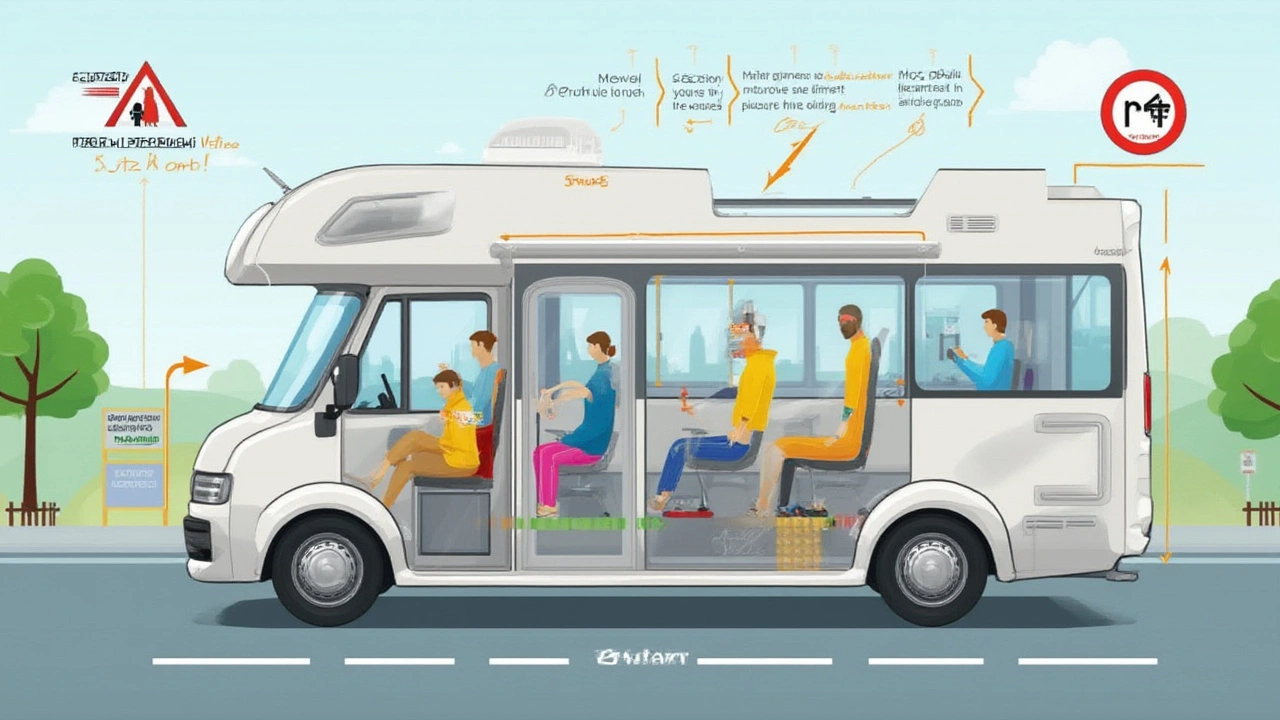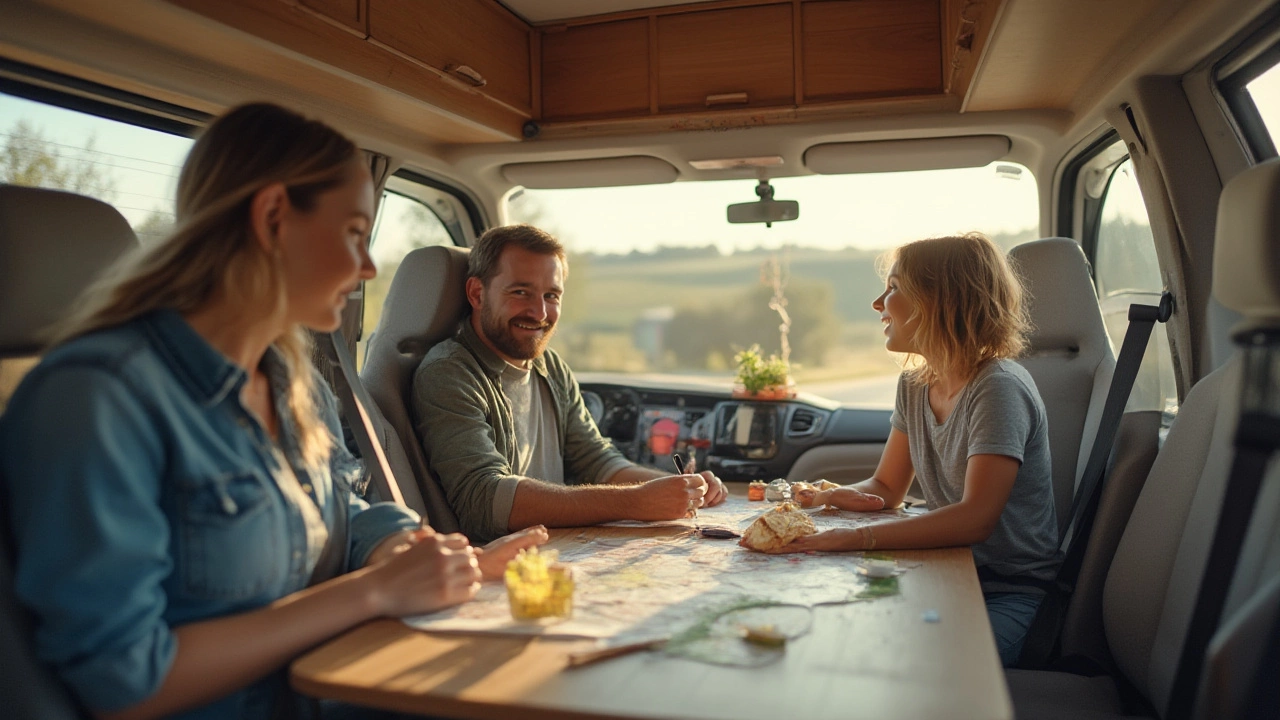Picture this: You're speeding down the motorway in a hulking RV, rain in the forecast, and the dog, Luna, sprawled across the nearest chair. Suddenly, the temptation hits. Could you just curl up on the plush sofa in the back? Thousands of folks, especially new RV owners, ask the same thing: Where is it actually safe — and legal — to sit while the RV is moving? It's not as obvious as it seems. Get this wrong, and you're risking more than a fine.
Legal Seats in an RV: The Surprising Truth
The idea of lounging wherever you want inside a rolling home seems romantic, but the law has other ideas. Across the UK, and most of Europe, you can only ride in a seat that's fitted with a seatbelt while the motorhome is in motion. This usually means the driver and the front passenger have obvious, proper seats, sometimes called 'captain's chairs.' In the main cab, you'll usually spot one or two more passenger seats. But can you park yourself at the dinette, stretch out on the bed, lean back in the lounge? Not unless those spots have official, fixed seatbelts.
The stricter rules came in after 2007, mainly to keep people from being flung around in a crash. According to UK law, every person in an RV that's on the move must be in a seat with an official seatbelt. If kids under 12 or under 135cm tall are riding with you, they're required to be in a child car seat approved for motor vehicles, just like they'd be in your car. Doesn't matter if you bought your RV used, or imported it, the rules apply to almost everything built after October 2007. If your RV is older, you can sometimes use original seats even if they're not belted, but you can't stick a passenger just anywhere. Insurance companies always want to see you're following the letter of the law, too. Ignore this at your peril — a stats table below tells the story.
| Situation | Legality (UK, post-2007) | Risk |
|---|---|---|
| Passenger in proper RV seat with seatbelt | Legal | Lowest |
| Passenger on rear sofa with no seatbelts | Illegal | Very high (no restraint in collision) |
| Child in correct child seat with seatbelt | Legal | Lowest |
| Person lying on bed while RV moves | Illegal | Extreme risk of injury/death |
In actual police crash reports I’ve read, unbelted people in RVs fare far worse than those in regular cars when things go wrong. If you thought "I'll just pop back and make a cuppa while we drive," think again.
Types of RV Seats: More Complicated Than You Think
Not all seats are built — or bolted — the same. In my Luna-powered travels, I've noticed RV interiors vary like fingerprints. The main types you’ll find are:
- Driver and front passenger seats: Always seatbelted, usually swivel for use at the campsite later.
- Dinette seats: Sometimes have seatbelts, sometimes they're just for use when parked. Kitchen booths, U-shaped lounges, or pullman dinettes can look tempting for road naps, but check under the cushions for factory-fitted belts.
- Side-facing sofas: These are almost never legal for use while driving. Sideways-facing seats aren’t crash-tested for forward or backward motion. Even if they have lap belts, insurance and DVLA frown on them.
- Beds, bunks, and reclining lounges: Strong “no” for all of these while moving, no matter how comfy they look.
European-style RVs (think Hymer or Burstner) toss in an extra snag: sometimes they’re certified with two to six legal travel seats, but often beds and extra sofas have zero belts. British makes like Bailey often have dedicated belted dinettes, a real win for families. Americans go nuts with their massive Class A rigs, but even there, seatbelt laws catch up with you. Bottom line: Don’t trust the cushioned rear bench — always check certificates and look for those little seatbelt tags.

RV Passenger Seat Safety: Common Myths and Hard Facts
My mate once argued that because coaches and trains go faster with people walking around, why not RVs? Problem: Those vehicles have commercial crash protections, and they're not private motorhomes, so the rules are different. You’ll see wild YouTube clips of people playing cards or making sandwiches in giant American RVs while moving, but don't copy them in the UK. In a crash at 30 mph, an unbelted person is thrown forward with a force equivalent to several tons — it doesn't matter if they're lying, walking, or sitting. One 2022 UK study found RV passengers without seatbelts were three times more likely to die or suffer serious injury in a crash. And if pets like Luna are with you? Keep them in a secured harness or pet carrier strapped to a seatbelt; a loose dog can turn into a dangerous projectile.
Some people think older RVs get a free pass. While vehicles registered before 2007 can use non-belted original seats, carrying extra people in camping chairs or on beds is never OK. Insurance companies may refuse pay-outs if someone is hurt while not properly restrained, even if it’s technically legal by age of the vehicle.
Who Sits Where? Tips for Families, Pets, and Weird Floor Plans
Got a big family? It takes planning. Don’t just assume five or six can ride together because there’s a sofa big enough. Count your seatbelts. Want to bring your mate and their two kids? If your RV only has three belted passenger seats, someone’s taking a separate car — or staying home. The same goes for dogs: Luna rides fine on the right-hand front passenger seat, clipped into her harness, where she can see out the window. If you have cats, pop them in their crate and belt them in too. And yes, most UK ferry companies now require proof your animals travel safely restrained.
Here’s a real tip: before buying a new or used RV, take time to physically inspect each passenger seat for real, bolted seatbelts. Don’t trust online ads — I learned this the hard way. Some floorplans show four seats, but only two have belts. Look for the official "Travel Seats: X" number on the manufacturer plate, usually by the main entrance. And don’t skip the rulebook on rainy days when you think “just this once” — accidents don’t care about weather or good intentions.
If you really want more travel seats, some motorhome specialists can retrofit seatbelts, but it’s a big job—safe, certified installation means reinforcing the seat to the frame. Expect to pay serious money for this, and it’s not legal in every case. Never use a lap belt in a sideways-facing seat with kids. And if you’re wild-camping and someone’s tired, stop the RV before anyone moves to the bed!

What About RVs in the Rest of Europe and America?
If you're planning to cross into Europe, make sure you know the local laws. France, Germany, and Spain are just as strict, if not more so, about using seatbelts in moving vehicles. For example, Spain will fine you on the spot if your passengers aren't buckled up. The French police sometimes stop British RVs looking for breaches. In Germany, the law covers every seat that has a belt. And if you’re hiring a motorhome abroad, double-check the seating layout—they often have fewer travel seats than sleeping berths. In Italy, you can be fined heavily just for kids not being in proper car seats.
Go further afield to North America, and things get wilder. In many US states, passengers can ride on couches or even beds in large Class A RVs — but it’s not safe. The National Highway Traffic Safety Administration says over 5,000 injuries happen yearly to unbelted RV passengers. Some states do require all front seat passengers to wear belts, but rear passengers? Rules are inconsistent, so play it safe, and always use installed seatbelts. Canadian provinces are stricter, usually requiring all passengers to be buckled no matter where they sit.
One last point, and it sounds odd: Some RV designs let you swivel a front seat to face the back. Don't do this while driving. Only use the seat in its driving position, facing forward. If you’re ever pulled over, police will check. Technically, changing a seat position while moving could get you in legal hot water, and it’s deadly dangerous if you crash.
In the end, it comes down to this: If the seat looks like it belongs in a car, faces forward, and has a proper seatbelt, you're good to go. Don’t risk crashing the adventure by ignoring simple safety — and when in doubt, check that little seatbelt tag. Luna, for one, agrees: she'd rather bark at squirrels from a clipped-in seat than risk flying through the air during a surprise stop.
